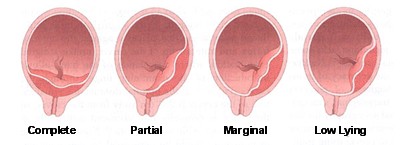Low lying placenta, medically known as placenta previa, is a rare condition during pregnancy. If not given proper attention, the condition can cause trouble at the time of delivery due to excessive bleeding and a Caesarian section may be needed. About one in two hundred women may experience placenta previa towards the end of their pregnancies.

What Happens When You Have Low Lying Placenta?
Placenta is a feature of the uterus that develops at the site where the fertilized egg attaches to the uterus. Because the fertilized egg is essentially free to attach itself anywhere along the inside of the uterus, at times, it may attach inside the lower part of the uterus. Then the placenta will begin to develop in a low-lying position towards the cervix. The help of an ultrasound can easily view the position of the placenta.
What Is Normal?
In the majority of cases where a low lying placenta develops at the beginning of the pregnancy, there is a significant chance of the placenta being pushed upwards by the uterus as the baby develops. In these cases, the danger posed by a placenta previa will be diminished as the pregnancy continues. This process is known as placental migration and if this occurs, there is no need for concern and you don't have to take much low lying placenta precautions.
When Do I Need to Concern?
If after twenty weeks, however, the placenta remains in a low-lying position, this is deemed as placenta previa. Even at this period, the placenta may still be pushed upwards though the possibility is much lower than at the beginning of the pregnancy. Finally, if towards the end of the pregnancy, the placenta has not migrated and remains in a low-lying position, the placenta will be covering the cervix, making natural birth impossible. A C-section will have to be carried out.
What Are the Symptoms of Placenta Previa?
There are few symptoms associated with a low lying placenta and these should be reported to your doctor immediately. First, your baby may be found to be in a breech or transverse position. This may be an indication that the baby is unable to take the right position because the placenta gets in the way. Second, painless vaginal bleeding in the second or the third trimester is an indication of a placenta previa. The bleeding may stop by itself but return several days later.
Do I Need to Take Precautions for Low Lying Placenta?
Low lying placenta precautions ought to be taken by pregnant women who have been diagnosed with a placenta previa. Here are the things you can do:
Once an ultrasound reveals its existence, you need to discuss with your doctor about the precautions you ought to take for your case in particular. In general, it is advisable to be aware of the two symptoms mentioned earlier and to report them to your doctor as soon as they occur. If you have had a C-section before, you should be aware that your chances of having a low lying placenta are increased and therefore you will have to discuss options for delivery with your doctor.
Can I Do Exercises?
Although exercising is a healthy and useful habit even for pregnant women, if you have a placenta previa, you may be advised by your doctor to abandon exercise completely. If, however, you are in the first trimester of your pregnancy, your doctor may actually encourage light exercise in hope that placental migration will take place. Always consult your doctor about the level of exercise you want to indulge in. You should avoid strenuous activity and sexual intercourse. Make sure you are alert to any vaginal bleeding.
Other Mums’ Stories About Low Lying Placenta
If you do get diagnosed with a placenta previa, don't be afraid because you are not alone. Below are some experiences shared by mums that have dealt with similar situations.
"My low lying placenta was diagnosed by scans at the 12th week. The placenta was not covering the cervix entirely. I had no bleeding and took no particular low lying placenta precautions. At 37th week, the placenta was still not covering the cervix entirely, but the opening was not enough for natural birth. Therefore, I was advised to have a C-section at 39th week. This was a very cautionary measure although I think if I was given a few more weeks to induce natural birth, I would still be fine. My baby was born at 2.5 kilograms and there were no major complications during the surgery."
"When I went in for the scans at 20 weeks, it was discovered that I had a low lying placenta though it was still three centimeters from the cervix. My doctor recommended light exercise and reassured me that there was a good chance of the placenta migrating upwards before birth. At 34 weeks, I went in for the scan again and surely the placenta had migrated! After the 40th week, I was able to birth my child vaginally."
"At my scan during the 18th week of pregnancy, my midwife told me that I had a low lying placenta. She told me not to worry though as there was a chance that the placenta would move as the pregnancy progressed. The midwife told me that if the placenta was less than two centimeters from the cervix, we would consult the obstetrician for the possibility of a C-section. The follow-up ultrasound came out fine, the placenta was not covering the cervix and I was able to give birth to my son naturally at home!"
